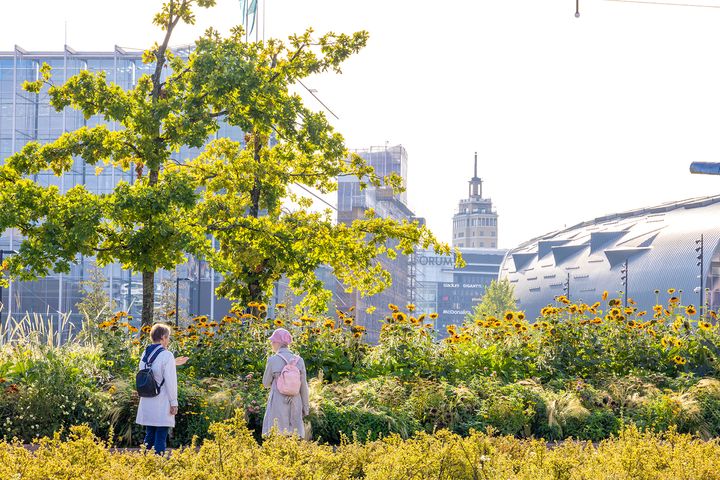EU Nature Restoration Law alone won’t halt urban biodiversity loss, says study
Urban greening alone has limited impact on biodiversity, and meeting EU restoration targets may require significantly densifying city structures, shows a new study.

In response to accelerating environmental crises, the European Union has introduced the Nature Restoration Law (NRL)—a landmark legislative effort to halt and reverse biodiversity loss across member states. A key component of the law is Article 8, which mandates the restoration of urban ecosystems. But how will growing cities balance these environmental demands with increasing population pressures?
A new study from Aalto University and the University of Helsinki—part of the CO-CARBON research project—examines this question using Helsinki as a case study. The results reveal that while the NRL offers an improvement over business-as-usual urban development, its current focus on quantitative green space targets will not, on their own, stop biodiversity loss in cities. The study advises that real restoration can only be achieved if the quality of green spaces is considered, not just the quantity.
‘Restoring biodiversity in expanding cities requires a holistic approach to planning. We need to reconcile population growth with green infrastructure that serves both people and nature. That means strategic, cross-sectoral decision-making focused not just on how much green space we have, but on how ecologically valuable it is,’ says postdoctoral researcher Antti Kinnunen, the study’s lead author.
The research modeled how various urban growth and greening scenarios would affect biodiversity and carbon sinks in Helsinki. It’s the first study of its kind in Finland, and among the first internationally, to explore the real-world implications of implementing the NRL in urban areas.
In a scenario based on the NRL’s minimum requirements, biodiversity declined less than under typical urban growth—but still resulted in a nearly 10% decline in the citywide biodiversity index. Only the most ambitious greening scenario, aligned with the law’s original goal of “no net loss,” led to a slight increase in biodiversity. Yet this scenario also required intensified urban density, reducing accessible green areas and potentially exacerbating climate impacts such as urban heatwaves.
The study highlights that the existing quantitative greening targets and treating all green areas as ecologically equal is problematic. For example, a hectare of lawn does not offer the same biodiversity or carbon sequestration potential as a hectare of woodland.
Moreover, urban green areas provide different benefits depending on their local context. The researchers call for biodiversity and climate targets to be pursued in parallel, while also recognizing when those goals may be in conflict. For instance, planting forests in open habitats may increase carbon storage but reduce biodiversity.
The researchers recommend that qualitative criteria concerning biodiversity and carbon sink potential for urban green spaces be integrated into Finland’s forthcoming national restoration plan. Although the NRL mandates monitoring at national and regional levels, both the benefits and the actions needed to achieve them take place locally. Cities must therefore embed biodiversity and ecosystem services into planning—from masterplans to the implementation of parks, street trees, and private gardens.
'This research underscores the need to merge top-down legislative targets with bottom-up, context-sensitive action,' Kinnunen says. 'Only then can urban nature truly recover.'
Keywords
Contacts
Antti Kinnunen
Postdoctoral researcher, Aalto University
+358 50 304 8227
antti.e.kinnunen@aalto.fi
Ranja Hautamäki
Professor, Aalto University
ranja.hautamaki@aalto.fi
Links
Information about the publisher
Aalto University is where science and art meet technology and business. We shape a sustainable future by making research breakthroughs in and across our disciplines, sparking the game changers of tomorrow and creating novel solutions to major global challenges. Our community is made up of 13 000 students, 400 professors and close to 4 100 other faculty and staff working on our dynamic campus in Espoo, Greater Helsinki, Finland.

Alternative languages
Subscribe to releases from Aalto-yliopisto
Subscribe to all the latest releases from Aalto-yliopisto by registering your e-mail address below. You can unsubscribe at any time.
Latest releases from Aalto-yliopisto
Kutsu: Miksi jokaisen lukiolaisen tulisi opiskella kauppatieteiden perusteita osana lukio-opintoja?8.9.2025 14:10:00 EEST | Kutsu
Kauppatieteitä lukiolaiselle -teos sisältää sellaiset tiedot, jotka jokaisen Suomen lukiolaisen tulisi osata, kun tämä siirtyy korkeakouluun ja työelämään.
Kolme Aalto-yliopiston kansainvälistä tutkijaa sai EU:n tavoitellun miljoonarahoituksen4.9.2025 13:00:03 EEST | Tiedote
Corinna Coupette, Maja Vuckovac ja Robin Welsch kehittävät tutkimushankkeissaan kestävämpiä oikeusjärjestelmiä, lääketiedettä hyödyntävää teknologiaa ja ihmiskeskeistä tekoälyä.
Aalto-yliopiston rehtori Ilkka Niemelä: Suomi tarvitsee uudistajia kasvuyrityksiin ja vakiintuneille aloille2.9.2025 15:09:07 EEST | Tiedote
Koulutetut ihmiset tuovat arvokkaan panoksensa yhteiskunnan uudistamiseen, sanoi Aalto-yliopiston rehtori Ilkka Niemelä lukuvuoden avajaispuheessaan.
Uusi koneoppimismenetelmä tekee tautiriskien ennustamisesta aiempaa tarkempaa26.8.2025 07:00:00 EEST | Tiedote
Tekoälytyökalu osaa hyödyntää terveystietojen monimutkaisia yhteyksiä ja tarjoaa siksi yksityiskohtaisempia riskiarvioita kuin perinteiset mallit.
Yli puolet korkeakoulutetuista maahanmuuttajista työllistyy Espoon ja Aalto-yliopiston kehittämällä palvelulla8.8.2025 07:00:00 EEST | Tiedote
Espoon kaupungin ja Aalto-yliopiston yhteistyöllä on saatu aikaan erinomaisia tuloksia korkeakoulutettujen maahanmuuttajien työllistymisessä.
In our pressroom you can read all our latest releases, find our press contacts, images, documents and other relevant information about us.
Visit our pressroom